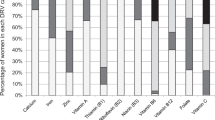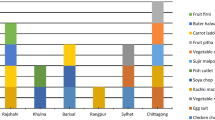Abstract
Background/objectives
Increasing dietary diversity is a viable strategy for addressing micronutrient malnutrition in women of childbearing age (WCA) from low-income countries. Recently, it has been demonstrated that some indigenous vegetables (IV) with high nutrient density may help to ameliorate micronutrient’s intake. The Minimum Dietary Diversity index for Women (MDD-W) could be considered as a proxy to describe one important dimension of women’s diet quality. This cross-sectional study aimed at exploring aspects contributing to micronutrients adequacy in Tanzanian WCA, with a focus on IV consumption and other socio-demographic factors.
Subjects/methods
Data collection was conducted among urban and peri-urban women in Arusha city, Tanzania. Socio-demographic factors were collected using a structured interview. Information on IV consumption and MDD-W calculation were obtained using a 24-h recall.
Results
One-hundred and forty-one women aged 14–49 years were interviewed. Sixteen per cent of the sample consumed at least one portion of IV/day. The total median MDD-W was 4.0 (IQR. 3.0–5.0) and it was adequate in the 44% of the sample. Women who consumed IV had MDD-W 0.66 points (95% CI: 0.02–1.30, p = 0.046) higher than those who did not; consuming IV had an odds ratio of more than three times concerning women not consuming IV (OR: 3.30, 95% CI: 1.24–8.81, p = 0.017).
Conclusions
The IV consumption is positively associated with micronutrient adequacy and its absence from the diet can be an indicator of micronutrient deficiencies in vulnerable people such as WCA. For that reason, this study suggests that IV consumption may improve micronutrient deficiency in WCA.
This is a preview of subscription content, access via your institution
Access options
Subscribe to this journal
Receive 12 print issues and online access
$259.00 per year
only $21.58 per issue
Buy this article
- Purchase on Springer Link
- Instant access to full article PDF
Prices may be subject to local taxes which are calculated during checkout
Similar content being viewed by others
References
Conti M, Campanaro A, Coccetti P, De Giuseppe R, Galimberti A, Labra M, et al. Potential role of neglected and underutilized plant species in improving women’s empowerment and nutrition in areas of sub-Saharan Africa. Nutr Rev. 2019;77:817–28. https://doi.org/10.1093/nutrit/nuz038.
Wrottesley S, Lamper C, Pisa P. Review of the importance of nutrition during the first 1000 days: maternal nutritional status and its associations with foetal growth and birth, neonatal and infant outcomes among African women. JDOHD. 2016;7:144–62. https://doi.org/10.1017/S2040174415001439.
Rivera M, Alvarez I. From a market approach to the centrality of life: an urgent change for women. In: Right to food and nutrition watch. 2017. p. 36–41.
FAO. Guidelines for measuring household and individual dietary diversity. FAO; 2013.
Jones AD. Critical review of the emerging research evidence on agricultural biodiversity, diet diversity, and nutritional status in low- and middle-income countries. Nutr Rev. 2017;75:769–82. https://doi.org/10.1093/nutrit/nux040.
Lachat C, Raneri JE, Walker SK, Kolsteren P, Van Damme P, Verzelen K, et al. Dietary species richness as a measure of food biodiversity and nutritional quality of diets. PNAS. 2018;115:127–32. https://doi.org/10.1073/pnas.1709194115.
Ochieng J, Afari-Sefa V, Lukumay PJ, Dubois T. Determinants of dietary diversity and the potential role of men in improving household nutrition in Tanzania. PLoS ONE. 2017;12:e0189022. https://doi.org/10.1371/journal.pone.0189022.
Chitambo O, Haukeland S, Fiaboe KK, Grundler FMW. African nightshade and African spinach decrease root-knot nematode and potato cyst nematode soil infestation in Kenya. Plant Dis. 2019;103:1621–30. https://doi.org/10.1094/PDIS-07-18-1193-RE.
FAO and FHI 360. 2016. Minimum dietary diversity for women: a guide for measurement. Rome: FAO.
Tanzania Government Profile. Index Mundi. 2019. https://www.indexmundi.com/tanzania/government_profile.html.
Borrelli N, Ndakidemi P. Small farmers for a food system transition: evidence from Kenya and Tanzania. Ledizioni; 2020.
Gitagia MW, Ramkat RC, Mituki DM, Termote C, Covic N, Cheserek MJ. Determinants of dietary diversity among women of reproductive age in two different agro-ecological zones of Rongai Sub-County, Nakuru, Kenya. Food Nutr Res. 2019;63. https://doi.org/10.29219/fnr.v63.1553.
Lukmanji Z, Hertzmark E, Mlingi N, Assey V, Ndossi G, Fawzi W. Tanzania food composition tables. MUHAS- TFNC, HSPH, Dar es Salaam Tanzania; 2008. http://www.hsph.harvard.edu/nutritionsource/more/food-tables/index.html.
Gibson RS, Charrondiere UR, Bell W. Measurement errors in dietary assessment using self-reported 24-hour recalls in low-income countries and strategies for their prevention. Adv Nutr. 2017;8:980–91. https://doi.org/10.3945/an.117.016980FAO.
Gonete KA, Tariku A, Wami SD, Akalu TY. Dietary diversity practice and associated factors among adolescent girls in Dembia district, northwest Ethiopia, 2017. Public Health Reviews. 2020;41:23.
Mubarik A, Tsou S. Combating micronutrient deficiencies through vegetables—a neglected food frontier in Asia. Food Policy. 1997;22.1:17–38.
Bellows AL, Canavan CR, Blakstad MM, Mosha D, Noor RA, Webb P, et al. The relationship between dietary diversity among women of reproductive age and agricultural diversity in rural Tanzania. Food Nutr Bull. 2019. https://doi.org/10.1177/0379572119892405.
Ochieng J, Afari-Sefa V, Karanja D, Kessy R, Rajendran S, Samali S. How promoting consumption of traditional African vegetables affects household nutrition security in Tanzania. Renew Agriculture Food Syst. 2018;33:105–15. https://doi.org/10.1017/S1742170516000508.
Chweya JA, Eyzaguirre PB. The biodiversity of traditional leafy vegetables. University of Nairobi; 1999.
Bvenura C, Afolayan AJ. The role of wild vegetables in household food security in South Africa: a review. Food Res Int. 2015;76:1001–11.
De Putter H, Van Koesveld MJ, De Visser CLM. Overview of the vegetable sector in Tanzania. Afriveg. 2007. http://hdl.handle.net/20.500.12018/7338.
Blakstad MM, Bellows AL, Mosha D. Neighbour home gardening predicts dietary diversity among rural Tanzanian women. Public Health Nutr. 2019;22.9:1646–53.
Gamuchirai C, Shackleton C. Minimum dietary diversity indexs for women indicate micronutrient adequacy and food insecurity status in South African towns. Nutrients. 2017;9:812.
Mazengoa MC, Simellc O, Lukmanjid Z, Shirimad R, Karvetti RL. Food consumption in rural and urban Tanzania. Acta Tropica. 1997;68:313–26.
Mshanga N, Martin H, Petrucka P. Food-basket intervention to reduce micronutrient deficiencies among Maasai-pregnant women in Tanzania: a quasi-experimental study. J Hum Nutr Diet. 2019;32:625–34.
Acknowledgements
The authors are very grateful to Dr Silvia Maffoni for the help in the data collection and to Dr Marco Gnesi for the statistical consultation.
Funding
Study approval was granted by the Sokoine University of Agriculture (SUA). To facilitate the research function, the Vice-Chancellor of the SUA was empowered to issue research clearance to staff, students, research associate and researchers of SUA on behalf of the Tanzania Commission for Science and Technology (Registration number: DPRTC/R/142 Val. II/10) within the ‘Sustainable Agri-Food Systems Strategies (SASS)’ project, funded by the Italian Ministry of University and Research (MIUR) (Fondo Integrativo Speciale per la Ricerca, FISR; CUP: H42F16002450001).
Author information
Authors and Affiliations
Contributions
Each author has participated actively in the work and has given substantial contribution. MVC, RDG, AGM, NHM and HC conceived and designed the work that led to the submission; MVC, AGM and NHM acquired data; MCM, MVC and RDG played a role in the statistical analysis; all the authors were involved in interpreting the results; MVC, RDG and MCM drafted the manuscript; SC, JM and HC revised the manuscript. All the authors agreed to be accountable for all aspects of the work in ensuring that questions related to the accuracy or integrity of any part of the work are appropriately investigated and resolved. Each author has read and approved the final submitted manuscript.
Corresponding author
Ethics declarations
Conflict of interest
The authors declare that they have no conflict of interest.
Additional information
Publisher’s note Springer Nature remains neutral with regard to jurisdictional claims in published maps and institutional affiliations.
Rights and permissions
About this article
Cite this article
Conti, M.V., De Giuseppe, R., Monti, M.C. et al. Indigenous vegetables: a sustainable approach to improve micronutrient adequacy in Tanzanian women of childbearing age. Eur J Clin Nutr 75, 1475–1482 (2021). https://doi.org/10.1038/s41430-021-00865-x
Received:
Revised:
Accepted:
Published:
Issue Date:
DOI: https://doi.org/10.1038/s41430-021-00865-x



